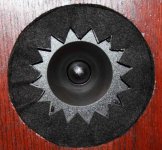This weekend I was reading about Duntech speakers, which are supposed to be legendary for their imaging. Each Duntech speaker has a patented star-shaped felt cut-out around the recessed time-aligned tweeter, which supposedly turns the tweeter into a true point source. Since my ACI Alpha project has time-aligned drivers (I think), I set about making my own version of the patented tweeter ring using felt and soft/dense weather stripping. Below you can see a picture of the finished project installed on my tweeters. The effects are very interesting! Each orchestral instrument now comes from a discrete position both in height and in side-to-side location. Some discs are astonishing now. On Pink Floyd’s DSOTM SACD, you can now tell that Waters and Gilmour are singing into the same mic, but from opposite sides. Being a trumpet player, I always listen to brass instruments on recordings. You can now clearly tell that the trumpets are to the left of the trombones and the horns are left of the trumpets (if sitting looking at the “stage”). All in all, I’m quite pleased for an outlay of about $10. Are there any downsides to a tweak like this? Is this a good idea for a horn-loaded tweeter? I think most designers that use something like this have dome tweeters. Is the star cu-out about the right size, or should it be smaller/bigger based on the size of the horn? Any feedback on this idea would be greatly appreciated.
Thanks
Chris
Thanks
Chris
Attachments
It tends to help the tweeter act more directionally and dampen edge diffraction from the mounting. On a horn, the output is largely directional to begin with, and there won't be much interaction with the felt (assuming it's not put inside the horn). Good tweak indeed, if it makes things sound better 
interesting indeed!
To know if it is working right you might be able to distinguish when using different sizes to test with.
You may be even able to reason whether one test piece is better than another knowing the size of the wavelengths the speaker is able to produce and at which frequency it should be dampened mostly.
Though probably differences in the size will not bring dramatical or even audible changes, because any dampening on the surface will help. Many tweeters are fitted with dampening foam in the baffle all over the surface(not with a star-shaped cutout). I think it helps to make the tweeter act better as a piont-source, so it will give better placing properties..
To my experience the higher the frequency the more sensitive the waves are to obstructions and reflections, therefore tweeters are often fitted in as small as possible housing (look at morel neodyme tweeters, one model is designed encased to fit on top of any bass-midrange cabinet. Or b&w nautilus..) For the housing is an obstruction by itself.
To know if it is working right you might be able to distinguish when using different sizes to test with.
You may be even able to reason whether one test piece is better than another knowing the size of the wavelengths the speaker is able to produce and at which frequency it should be dampened mostly.
Though probably differences in the size will not bring dramatical or even audible changes, because any dampening on the surface will help. Many tweeters are fitted with dampening foam in the baffle all over the surface(not with a star-shaped cutout). I think it helps to make the tweeter act better as a piont-source, so it will give better placing properties..
To my experience the higher the frequency the more sensitive the waves are to obstructions and reflections, therefore tweeters are often fitted in as small as possible housing (look at morel neodyme tweeters, one model is designed encased to fit on top of any bass-midrange cabinet. Or b&w nautilus..) For the housing is an obstruction by itself.
- Status
- This old topic is closed. If you want to reopen this topic, contact a moderator using the "Report Post" button.
